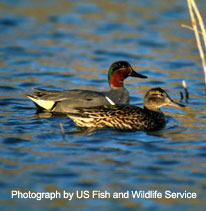Wildlife - Species

Species Specific Regulations
Green-Winged Teal
Licenses: Hunting License required. Migratory Bird Hunting and Conservation Stamp (Federal Duck Stamp) that is validated by the hunter signing the stamp in ink across the face of the stamp
Limits: Please see Migratory Bird Regulations for any game zones restrictions or Limitations.
Green-winged Teal (Anas crecca)

Description
This is North America’s smallest dabbling duck. The brightly patterned drake has a green and reddish head and a white stripe along the shoulder. Their speculum is greenish towards the inner wing and black towards the outer wing. Early fall drakes are usually still in full eclipse plumage.
Average Size
Green-winged teal have an average length of 15 inches and an average weight of 14 ounces.
Range
They nest as far north as Alaska, and migrate in all four flyways. They are a common winter resident in South Carolina.
Preferred Habitat
Quite hardy—some birds stay as far north as open water is found. They nest as far north as Alaska, and migrate in all four flyways. Early fall drakes are usually still in full eclipse plumage.
Typical Flock Pattern

Wings

Food Habits
Green-winged teal are opportunistic foragers, consuming a wide variety of seeds, aquatic insects, mollusks, and crustaceans.
Reproduction
Pair bonds are formed on the wintering grounds. The hen builds the nest in sedge meadows, grasslands, and brush thickets in close proximity to water. She scrapes a nest bowl into the ground and pulls surrounding vegetation around nest bowl. Here she lays 6-9 creamy white to buff eggs.
Sound
Drakes whistle and twitter, and hens have a slight quack.
Behavior
- Quite hardy—some birds stay as far north as open water is found.
- Flight is often low, erratic, with the entire flock twisting and turning as one unit.
- Green-winged teal are the only species of duck known to scratch in flight.
- Rarely dives for food, but will dive to avoid predators.
- Often perches at low levels above the water.
- Have overlapping territories with other males during the breeding season.
- Very gregarious during the winter months and are often found in flocks numbering in the hundreds.
Citations, Publications and Literature
U.S. Fish & Wildlife Service, Federal Duck Stamp Office Presents: North American Waterfowl (Adobe PDF file)
Johnson, Kevin. 1995. Green-winged Teal (Anas crecca), The Birds of North America Online (A. Poole, Ed.). Ithaca: Cornell Lab of Ornithology; Retrieved from the Birds of North America Online